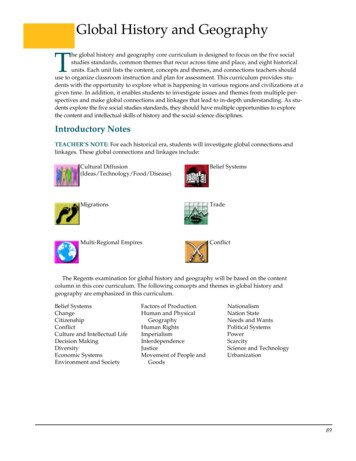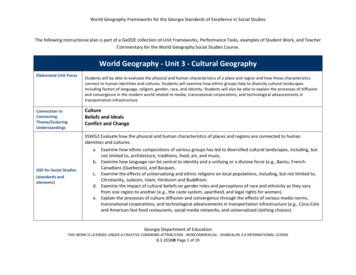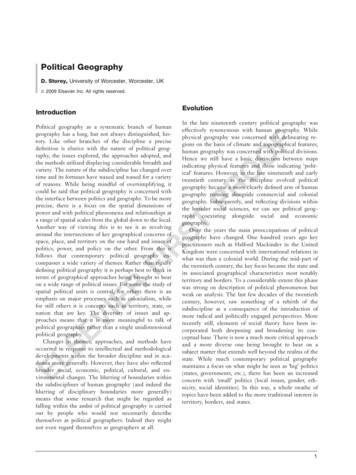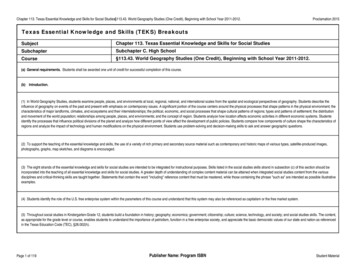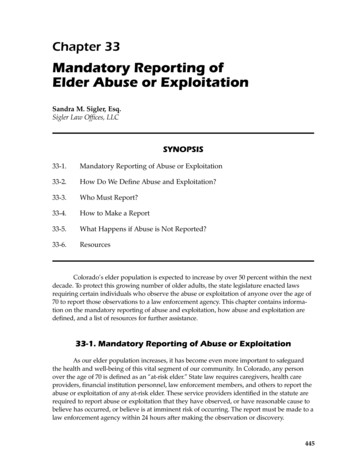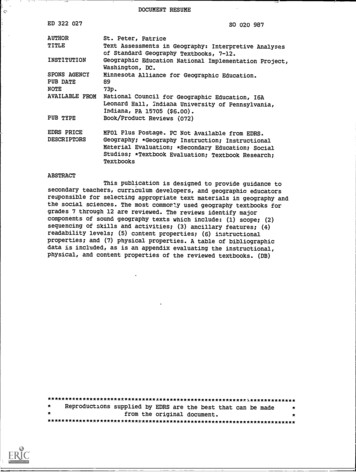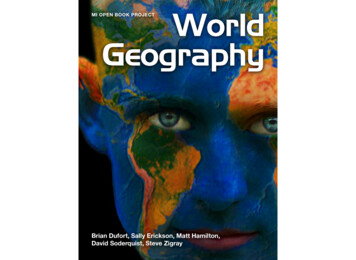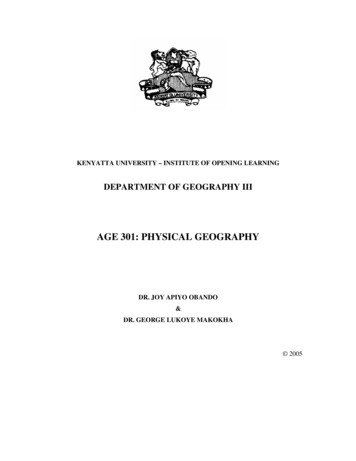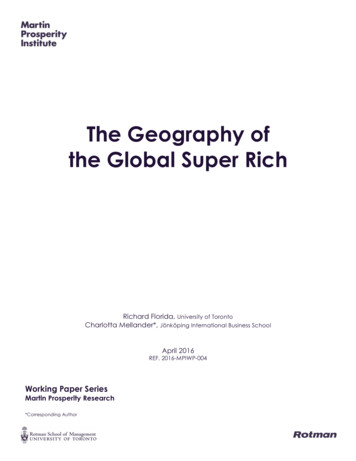
Transcription
The Geography ofthe Global Super RichRichard Florida, University of TorontoCharlotta Mellander*, Jönköping International Business SchoolApril 2016REF. 2016-MPIWP-004Working Paper SeriesMartin Prosperity Research*Corresponding Author
Abstract:Over the past decade or so, there has been increasing concern over risinginequality and the growth of the 1 percent of super-rich people who sit atopthe global economy. While studies have charted the super-rich by industry andnation, there is very little research on their location by city or metro area. Ourresearch uses detailed data from Forbes (2015) on the world’s billionaires to testa series of hypotheses about the location of the super-rich across the world’s citiesand metro areas. We find that the super-rich are concentrated in a small numberof metros around the world and that their location is primarily related to the size ofmetros: Large metros offer more people bigger markets, more diversified industriesand more opportunity that help produce and attract billionaires. The location ofthe super-rich is more modestly associated with living standards (measured aseconomic output per capita) and less so with the presence of finance and techindustries, and city competitiveness. Their location is not related to quality of life,which is somewhat surprising in light of the level of mobility the super-rich enjoy,as well as research that finds that affluent and talented people are attractedto higher quality, higher amenity places.Keywords: Super-rich, billionaires, 1 percent, geography, size, quality of life,competitiveness, spatial division of laborJEL: R12, O15
IntroductionOver the past decade or so, there has been increasing concern over rising inequalityand the growth of the 1 percent of super-rich people who sit atop the global economy(Freeland, 2012; Hardoon, 2015; Hay, 2013; Piketty, 2014; West, 2014). Piketty (2014) hasidentified the returns to capital held by the super-rich as a key source in rising wealthinequality. A study by Oxfam International (Hardoon, 2015) suggests that the world’s 62richest individuals hold wealth that is equivalent to that of the entire bottom half of theworld’s population. Freeland provides a host of qualitative information on the rise of thesuper-rich around the world (Freeland, 2012). Beaverstock and Hay collect a variety ofstudies on the growth and geography of the super-rich across the globe — but a mainpoint of the volume is that the super-rich are not just a class in and of themselves, butalso take on a particular geography or spatial patterning across and within cities(Beaverstock & Hall, 2016).For all the concern expressed about the rise of global super-rich, there is very littleempirical research on them. While several recent studies have charted the locationof the super-rich by nation and explored other of their characteristics (Freund & Oliver,2016; Hay, 2013), there is very little research on their location by city or metro area.Our research uses detailed data from Forbes (Forbes, 2015) on the world’s billionairesto examine the geography of the super-rich across the world’s cities and metro areas.It looks in detail at the source of that wealth — the degree to which it is self-made versusinherited – and maps the major industries and sectors that define the super-rich acrossthese global metros. It also explores the concentration of wealth within global metros,charting the share of total economic output that the super-rich control and comparingthe wealth of the super-rich to the economic status of the average person acrossglobal cities.Several studies use the Forbes data to examine various dimensions of the world’sbillionaires. Freund and Oliver compiled these data over two decades to chartbillionaire trends across nations and industries (but not across cities or metros),identifying the substantial increase in billionaires in the United States and emergingeconomies, the growth of billionaires in specific industries, notably finance and tech,and the rise of self-made billionaires in the United States and Europe compared tothe inherited wealth in Europe (Freund, 2016; Freund & Oliver, 2016). Piketty (2014) alsouses the Forbes data along with data from many other sources to chart the increase inwealth inequality across nations. Kaplan and Rauh use the Forbes data for various yearsfrom 1987 to 2011 to compare U.S. billionaires to billionaires across the rest of the world,examining the sources of their wealth across industry and whether that wealth is selfmade as opposed to inherited (Kaplan & Rauh, 2013). They find that the rise ofAmerican billionaires uniquely reflects the rise of high tech industry, the broader shiftMPI Working Paper Series: The Geography of the Global Super Rich (Florida & Mellander)3
toward skills-biased technological change, and the super-profits derived by techsuperstars like Apple, Microsoft, Google and others. Bagchi and Svejnar (2015) useForbes data to look at the effects of two types of billionaire wealth on nationaleconomic growth — wealth that is politically-connected and wealth that isunconnected from politics. They find that unconnected wealth is not associatedwith economic growth while politically-connected wealth is negatively associatedwith economic growth (Bagchi & Svejnar, 2015). Other studies have used the Forbesdata to chart the rise in billionaires in other nations and parts of the world: Gandhiand Walton (2012) for India and Guriev and Rachinsky (2005) on the role of oligarchsin Russia’s transition to capitalism.Our research takes shape around five core hypotheses. The first and most basic one isthat the location and geography of the super-rich will be a function of the size of metroareas. Larger metros have more people, bigger markets, more talent or human capital,a more diverse set of industries and inputs, and more competition, all of which are likelyto both produce and attract more of the super-rich (Florida, 2002; Glaeser, Kolko, & Saiz,2001; Gyourko, Mayer, & Sinai, 2006). We also know that the geographic structure of theglobal economy has become more concentrated, skewed and spiky with the largestcities and metros attracting a larger share of talent and advanced industries (Florida,2005; Florida, Gulden, & Mellander, 2008).The second hypothesis is that the location of the super-rich will be associated withmetros with higher living standards. Here, we expect that it is not just overall size, butliving standards as well, that will affect the location of the super-rich. Metros with alarger middle class will generate greater demand for the kinds of industries andcompanies that produce billionaires. Metros with higher living standards wouldalso benefit from better educational institutions that would produce talent andlead to more advanced tastes and preferences.The third hypothesis is that the location of the super-rich will be associated with certainkinds of industry and industry structures. Freund and Oliver (2016) identify the rise in thesuper-rich over the past two decades as being associated with the increasing returnsto two industries in particular: finance and high-tech. We would thus expect metroswith larger concentrations of these two industries to be home to larger numbers ofbillionaires.The fourth hypothesis is that the location of the super-rich will be associated with moreeconomically competitive cities and metro areas. A wide body of literature suggeststhat higher levels of economic growth and development are closely associated withcompetitiveness, defined as honest and transparent government, high qualityeducational institutions and infrastructure, reasonable tax regimes, effectivegovernment provision of services and other related factors.MPI Working Paper Series: The Geography of the Global Super Rich (Florida & Mellander)4
The fifth hypothesis is that the location and geography of the super-rich will beassociated with higher quality, higher amenity, and more livable places. A largeand growing body of literature (Albouy, 2009; Glaeser et al., 2001; Lloyd & Clark,2001) notes the preference of the skilled and the affluent for higher amenity as wellas higher productivity locations. The super-rich are highly mobile and can afford tolive in beautiful places that offer high quality of life. Even smaller places with limitedindustry like Monaco, Jackson Hole, or Palm Beach are noted locations for the superwealthy. We would thus expect to see some fraction of the super-rich drawn to suchhigh-amenity, high quality of life places (Boschma, 2004; Maskell & Malmberg, 1999;Porter, 1998, 2008).To examine these hypotheses, our research uses the Forbes data to chart the locationand geography of billionaires across the world’s cities and metro areas. (The nextsection describes our methodology for doing so). Following other studies, it looks atthe location of these billionaires by global metro, by industry, and by source of wealth— self-made versus inherited. It also conducts a statistical analysis of the factors thatshape the geographic distribution of the super-rich based on the size of metros, theirliving standards, finance and tech industries, competitiveness and quality of life. Wefind that the location of the super-rich is generally most closely associated with the sizeof metros. Living standards play a more modest role in location, with the presence offinance and tech industries and competitiveness being more weakly associated withthe location of the super-rich. We find little effect for quality of life and this effect is oftennegative. We conclude that the location of the super-rich is primarily driven by the sizeof global metros.The next section outlines the data, variables, and methods used in our analysis. The bulkof the article summarizes the key findings of our descriptive, mapping, and statisticalanalyses. We summarize our main findings and discuss some of their implications in theconcluding section.MPI Working Paper Series: The Geography of the Global Super Rich (Florida & Mellander)5
Data, Variables, and MethodologyWe base the analysis on data from Forbes’ Billionaires List for 2015 (Forbes, 2015).It covers 1,826 billionaires globally and includes information on a number of factorssuch as their net worth, country of origin, citizenship, location of primary residence, age,marital status, industry, if their fortunes are inherited or self-made, and how their fortunesare trending over time. One caveat: only billionaires whose money was accumulatedthrough legal means are included in the Forbes data; those whose fortunes are tied tocorruption, drugs, or other similar illegal activity are excluded from the list.Forbes provides information about primary residence and we matched the billionairesto global cities or metropolitan areas based on this. To do so, we use the global metrodefinitions identified by Brookings Institution for the world’s 300 largest metros (Brookings,2014) including their primary cities and surrounding suburbs. If the city of primaryresidence falls within a Brookings metro, it is assigned to that metro. If it falls outsideany known metro boundary, it is kept as the initial city of residence.We ultimately match 99 percent (1,809 of 1,826) of the billionaires to metros. We wereunable to match 17 of them to a specific location. These 17 billionaires account for onepercent of total billionaire wealth or 67.7 billion dollars. Three reside in France, two inFinland, and one each in Germany, Italy, Switzerland, and the Philippines. We couldnot definitively identify countries of residence for eight others, although their citizenshipis German. Ultimately, we matched and mapped these 1,809 billionaires across 395metros or regions.We chart the geography of the global super-rich by their number and by theirtotal wealth. We also chart the geography of the global super-rich by major industrysector. Here, we aggregated a number of the industry categories in the Forbes data,combining finance and investments; technology and telecom; oil and energy; metalsand mining; automotive and manufacturing; medicine and health care; fashion andretail; and sports and gaming. The data also identify the extent to which their wealthis self-made versus inherited.We developed two measures of the concentration of super-rich wealth by metros:a ratio of billionaire wealth to total metro economic output and a ratio of billionairewealth to the economic output per capita. We limit both to metros with ten or morebillionaires. Here we note that our measures compare the level of wealth of the superrich, which may have accrued over long periods, to the economic output of metrosfor one year. Additionally, since the super-rich are mobile, their wealth may have beenbrought with them from other places.MPI Working Paper Series: The Geography of the Global Super Rich (Florida & Mellander)6
To better understand the factors that are associated with the location of the globalsuper-rich, we conduct both a bivariate correlation analysis and a regression analysis.The variables we use in the statistical analysis area as follows:Dependent VariablesBillionaires: We employ two alternative measures for billionaires by metro: Number of Billionaires: This is the number of billionaires per metro. Billionaire Wealth: reflects the total wealth held by billionaires in that metro.Independent VariablesWe employ the following independent variables in our analysis:Size: We use two measures for size: Population Size, based on population and EconomicSize, based on economic output to capture the overall size and market size of themetro area. Population Size is total metro population in 2014 as per the Brookings MetroMonitor report (Brookings, 2014). Economic Size is total metro economic output, alsofrom Brookings (2014). We matched both size variables for 182 metros with billionaires.Living Standards: We use economic output per capita to capture the living standards ofmetro populations. The data is for 2014 and comes from Brookings (Brookings, 2014). Wematched this data for 182 metros as well.Tech: Freund and Oliver (2016) show the rise in billionaires to be related to high-techindustry. We use venture capital investments (expressed in millions of dollars) in hightech startups to reflect that rise. The variable is from Florida and King (2016), based ondata from Thompson Reuters. We matched it for 124 metros.Finance: Freund and Oliver (2016) also show the rise in billionaires to be related to thefinance industry. We measure this via the Global Financial Centres Index developed bythe Z/Yen Group for the year 2015 (Z/Yen, 2015). This index includes measures related tothe financial power of global cities including their overall business environment, financialsector development, financial infrastructure, talent base, and reputation. We matchedthis data for 58 metros.City Competitiveness: We use a measure from The Economist Intelligence Unit andCitigroup (Economist Intelligence Unit, 2013) which includes indicators of economicstrength, physical capital, financial maturity, institutional character, human capital,global appeal, social and cultural character, and environment and natural hazards.We matched these data for 87 metros.Quality of Life: There is a considerable literature that suggests that more affluent peopleare drawn to locations that offer a higher quality of life and more amenities, which arein turn reflected in higher housing prices (Albouy, 2009, 2015; Glaeser, Kolko & Saiz, 2001;MPI Working Paper Series: The Geography of the Global Super Rich (Florida & Mellander)7
Roback, 1982). We include a measure of the Quality of Life variable to capture this. TheQuality of Life variable is based on the Economist Intelligence Unit’s Livability Index (EIU,2012) which includes data on political stability, healthcare, culture and environment,education and infrastructure. We matched this data to 85 metros.Table 1 lists the descriptive statistics for all the variables used in the analysis.NMinimumMaximumMeanStd. DeviationBillionaires (Number)1821116814Billionaire Wealth (Billions of dollars)18215373264Population Size182609,47037,027,8005,997,8096,284,816Economic Size (Millions of dollars)18232,0141,616,792190,522210,995Living Standards1824,03683,08839,44718,079Tech (Millions of dollars)12456,471244690Finance5853678666653City Competitiveness873876559Quality of Life8553988313Table 1: Descriptive StatisticsIn the correlation and regression analysis, we only include metros with billionairespresent, in other words, metros without billionaires are excluded from the analyses. Dueto the skewed distribution, we log the following explanatory variables: the Number ofBillionaires and Billionaire Wealth as well as Population Size, Economic Size, and Tech.In light of our theory and hypotheses, the regression analysis considers the location ofthe super-rich (both Billionaires and Billionaire Wealth) as a function of Size measuredboth as Population Size and Economic Size, and several other factors or metro qualitiesincluding: Living Standards, Industry Structure (especially Finance and Tech), CityCompetitiveness, and Quality of Life. We use a standard OLS estimation techniqueto estimate the equation. Our basic model is as follows:ln Billionaires* α β0 lnSize* β3 LivingStandards* β9 ΣMetroQualities* εwhere Billionaires is represented either by the number of billionaires or their total metrowealth. It is important to note that data limitations lead to missing observations forseveral key variables. When we include all variables in the model, we end up withmatching data for just 40 metros. To deal with this, we include one variable at a timein the regression analysis, controlling for market size. We also repeat the regressions,replacing the missing observations with mean values.MPI Working Paper Series: The Geography of the Global Super Rich (Florida & Mellander)8
FindingsWe now turn to the findings of our analysis. We begin with basic descriptive data andmaps that provide an overview of the global location of the super-rich, then turn to thefindings of the statistical analysis.Characteristics of the Global Super-RichWe begin with the key descriptive characteristics of the global super-rich. The world’s1,826 billionaires make up just 0.00003 percent of the world’s population, but hold anincredible amount of wealth. With a combined wealth of more than 7 trillion in 2015,their fortunes are comparable to Japan’s entire economy — the world’s the third largest— and make up nearly 10 percent of the total global economic output. The world’s 50wealthiest billionaires control 1.6 trillion, more than Canada’s economy, while the top10 control 556 billion, roughly the economic size of Algeria or the United Arab Emirates.The United States is home the world’s largest number of billionaires, with 541, 30 percentof the total. China is second with 223 or 12 percent. Next in line are India and Russia,with 82 billionaires (4.5 percent) each. Germany is fifth with 78 billionaires (4.3 percent).The United Kingdom is sixth with 71 (3.9 percent). Switzerland has 58 (4.3 percent), Brazil50 (2.7 percent), France 39 (2.1 percent), and Italy 35 (1.9 percent). Freund and Oliver(2016) note the sharp rise in billionaires in emerging economies between 1996 and 2014.Not surprisingly, the world’s billionaires are overwhelmingly male. Women makeup roughly 10 percent (10.8 percent), and control a similar share (10.9 percent) oftotal wealth. Billionaires are on average 61 years of age. More than 40 percent (43.9percent) are 65 or older. Just 2.5 percent (45 of them) are under 40 years of age, andjust 0.2 percent (three of them) are under 30. Nearly three-quarters of billionaires (1,367)are married, while just 3 percent (3.5 percent, 63) are single and 7 percent (6.7 percent,123) are divorced or separated.The data also allow us to look at the share of billionaires whose wealth is inheritedversus those who are self-made. According to Freund and Oliver (2016), the share ofself-made wealth has increased substantially over the past two decades, rising from45 percent in 1996 to nearly 70 percent in 2015. There is a significant geographic dividehere. Billionaires in Europe are far more likely to have inherited their wealth comparedto billionaires in the United States and China. As of 2014, more than half of Europeanbillionaires inherited their wealth compared to just a third of billionaires in the UnitedStates. European fortunes are also much more likely span multiple generations, as thechart below shows. Over 20 percent of Europe’s inherited fortunes were four or moregenerations old, compared to less than 10 percent in the United States (Freund andOliver 2016). The self-made billionaire wealth in the United States comes from twosources: tech companies, and even more so from the financial sector. The U.S. hasMPI Working Paper Series: The Geography of the Global Super Rich (Florida & Mellander)9
a greater number of self-made tech billionaires, 56 billionaires or 12 percent, comparedto 17 billionaires or just 5 percent from Europe. More than 40 percent of the U.S.billionaires can be attributed to the financial sector s — many of whom derive theirwealth from hedge funds — compared to 14 percent in Europe and 12 percent inother advanced countries.As Figure 1 shows, this varies considerably by metro. (The blue bars indicate thepercentage of billionaires whose wealth is self-made, while the purple bars showthose billionaires whose wealth is inherited.)Figure 1: Inherited versus Self-Made Wealth across Global MetrosMetros in the United States and Asia, especially China, have the largest shares of selfmade wealth, while those in Europe and South America have more inherited wealth.The 10 leading metros for self-made wealth include Beijing, Shenzhen, Guangzhou,and Hangzhou in China, Moscow, San Francisco, Los Angeles, Boston, and Sydney.The leading metros for inherited wealth are mainly in Europe, South America, and Indiaand include Bielefeld-Detmold, Germany, Monaco, Sao Paulo, Seoul, Delhi, Stockholm,Mumbai, Zurich, Santiago, and Paris.MPI Working Paper Series: The Geography of the Global Super Rich (Florida & Mellander)10
The Super-Rich across Global Cities and MetrosWe now turn to the results of our geographic analysis of the locations of the super-richacross the world’s cities and metro areas.Figure 2: The Global Super-Rich by Major Global City and MetroFigure 2 maps the number of billionaires by metro. New York tops the list with 116billionaires or 6.4 percent of the world’s billionaires. The San Francisco Bay Area issecond with 71 (3.9 percent), Moscow third with 68 (3.7 percent), and Hong Kongfourth with 65 (3.5 percent). Three additional metros have between 2 and 3 percentof the global super-rich: Los Angeles (2.8 percent), London (2.7 percent), and Beijing(2.5 percent). Each remaining city in the top 20 accounts for between 1 and 2 percentof the world’s billionaires. Four of the top 10 global cities for the super-rich and six of thetop 20 are in the United States.We now chart the total wealth held by the super-rich across the cities and metros of theworld (see Figure 3).MPI Working Paper Series: The Geography of the Global Super Rich (Florida & Mellander)11
Figure 3: Super-Rich Fortunes by Global City or MetroNew York again tops the list with 537 billion or 7.6 percent of all global billionairewealth. San Francisco is second with 365 billion or 5.2 percent; Moscow third with 290 billion or 4.1 percent; Hong Kong fourth with 274 billion or 3.9 percent; andLondon is fifth with 213 billion or 3.0 percent. Los Angeles ( 175 billion, 2.5 percent),Beijing ( 171 billion, 2.4 percent), Paris ( 167 billion, 2.4 percent), Seattle ( 164 billion,2.3 percent), and Dallas ( 156 billion, 2.2 percent) complete the top ten. The UnitedStates has five metros in the top 10 and 9 in the top 20 on this metric.Table 2 shows the concentration of the super-rich across the world’s cities andmetro areas.MPI Working Paper Series: The Geography of the Global Super Rich (Florida & Mellander)12
Top 10 MetrosTop 20 MetrosTop 50 Metros5607951,152Share30.7%43.5%63.1%Wealth (billions) 2,307 3,183 4,710Share32.7%45.1%66.8%Share of World .0%Wealth (billions) 2,511 3,437 4,983Share35.6%48.7%70.6%Share of World Population1.6%3.5%6.9%Number of Billionaires:NumberBillionaire Wealth:NumberTable 2: The Geographic Concentration of the Global Super-RichThe top 10 metros account for nearly a third (30.7 percent) of the world’s super-rich,while making up just 1.8 percent of the world’s population. The top 20 account formore than 40 percent (43.5 percent), while making up just 3.5 percent of the world’spopulation. The top 50 metros account for nearly two-thirds (63.6 percent) of the world’sbillionaires, while making up just 7 percent (7.2) percent of the world’s population.The wealth of the super-rich is even more concentrated than their numbers. The top tenmetros control 2.5 trillion dollars, more than the total GDP of Brazil, Italy, or India. Thetop 20 metros account for 3.4 trillion, equivalent to the GDP of Germany, the world’sfourth largest economy. And the top 50 account for almost 5 trillion, equivalent to theworld’s third largest economy, after the United States and China, and accounting formore than 70 percent of all billionaire wealth. Ultimately, the number of billionaires andtheir total wealth is closely associated across global metros, with a correlation of 0.87.MPI Working Paper Series: The Geography of the Global Super Rich (Florida & Mellander)13
Figure 4: Ratio of Super-Rich Wealth to Metro Economic OutputFigure 4 takes a different tack on the concentration of billionaire wealth, comparingthe wealth held by the super-rich to the total economic output of their respectivemetros (we limit this analysis to metros with more than ten billionaires). Across theworld, the fortunes of the super-rich are equivalent to a significant portion of the totaleconomic output of the entire cities and metro areas in which they reside. The wealthof the super-rich in London or Sao Paolo is equivalent to about a quarter of their totalannual economic output. In Mexico City and Beijing it is equivalent to about a thirdof annual economic output. In New York and Stockholm it is about 40 percent, and inSeattle it is around half. In Hong Kong it is 70 percent and in San Francisco roughly threequarters. In Geneva, a small city with many wealthy people, the fortunes of the superrich are equivalent to more than 150 percent of annual economic output. Ultimately,this ratio tends to reflect the wealth of billionaires with correlation of .47.MPI Working Paper Series: The Geography of the Global Super Rich (Florida & Mellander)14
Figure 5: Ratio of Super-Rich Wealth to Economic Output per PersonFigure 5 maps the ratio of billionaire wealth to economic output per person by metro.(We limit this analysis to metros with ten or more billionaires.) The magnitude of the gapis staggering, with the fortunes of the super-rich ranging from 100,000 to more than600,000 times greater than the economic conditions of the average person in the 20metros with the largest overall wealth gaps. Most of these cities are in the relatively lessdeveloped nations of the Global South, where the middle class is much smaller, povertyis substantially greater, and average incomes are much lower than in the advancedeconomies. In fact, 14 of these 20 cities are in the Global South. Bangalore tops thelist, followed by Mumbai and Mexico City. Manila, Jakarta, Delhi, Bangkok, Hangzhou,Beijing, Shanghai, Rio de Janeiro, Sao Paulo, Santiago, and Dubai all number amongthe top 20 cities with the largest super-rich wealth gaps. Six cities in advanced nationsnumber among the top 20 as well: Seattle, Dallas, Paris, Stockholm, Toronto, and Tokyo.MPI Working Paper Series: The Geography of the Global Super Rich (Florida & Mellander)15
The Super-Rich by IndustryNow that we have looked at the overall geography of the super-rich, we turn to theirgeography across key industries. Table 3 lists the top ten industries where the super-richderive their fortunes.Billionaire Wealth(billions)Share of TotalBillionaire Wealth 1,10015.6%Technology and Telecom 98914.0%Finance and Investment 96213.6%Resources(Oil, Energy, Metals and Mining) 6238.8%Automotive and Manufacturing 5617.9%Food and Beverage 5427.7%Diversified 5397.6%Real Estate 5267.5%Media 3555.0%Medicine and Health care 3084.4%IndustryFashion and RetailTable 3: Leading Industries for Super-Rich WealthOne might think of finance, high-tech, and energy as leading sources of wealth,but Fashion and Retail tops the list with over a 1 trillion, more than 15.6 percent oftotal billionaire wealth. This sector includes billionaires associated with companies likeWal-Mart, H&M, Nike, L’Oréal, and Chanel. Technology and Telecom is second, with 989 billion, 14 percent of the total. Finance and Investment is third with 962 billion,(13.6 percent). Resources is fourth with 623 billion (8.8 percent) and Automotive andManufacturing is fifth, with 561 billion (7.7 percent). The top four sectors account forover half of all billionaires, while the top five account for 60 percent.The following maps dive deeper into how billionaires break out across the threeleading industries for billionaire wealth: Fashion and Retail, Tech and Telecom, andFinance and Investment.MPI Working Paper Series: The Geography of the Global Super Rich (Florida & Mellander)16
Figure 6: The Geography of Fashion and Retail BillionairesFigure 6 maps the geography of billionaire wealth for the fashion and retailindustry. There are large dots across the United States and much of Europe, andmuch smaller dots in Asia, the Middle East, and South America. Paris tops the list,followed by Bentonville (home to Wal-Mart), Milan, Jackson, Wyoming (home toone of the members of the Walton/Wal-Mart f
billionaire trends across nations and industries (but not across cities or metros), identifying the substantial increase in billionaires in the United States and emerging economies, the growth of billionaires in specific industries, notably finance and tech, and the rise of self-made billionaires in the United States and Europe compared to

